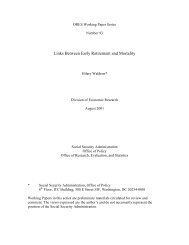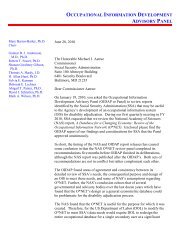Download entire publication - Social Security
Download entire publication - Social Security
Download entire publication - Social Security
Create successful ePaper yourself
Turn your PDF publications into a flip-book with our unique Google optimized e-Paper software.
non-Hispanic white, and college educated have moreexperience in the labor force and are in the highestshared lifetime earnings and retirement income quintiles;they are also most likely to have DB pensionsand DC retirement accounts (Table 4). 15Demographic groups most likely to have pensionsalso have higher average family incomes and areprojected to be most affected by the pension shift.Under the baseline, mean family income per person ishighest for men, married adults, non-Hispanic whites,college graduates, those with 30 or more years oflabor force experience, and those in the top quintileof shared lifetime earnings—in every boomer wave(Table 5). Both the absolute and percentage declines inaverage family income per person between the baselineand U.K. scenarios are largest for many of theseTable 4.Percent of individuals with family pensions at age 67 under the baseline scenario, by selectedcharacteristics and pension typeCharacteristicFirstboomers(1946–1950)DB benefitsSecondboomers(1951–1955)Thirdboomers(1956–1960)Lastboomers(1961–1965)Firstboomers(1946–1950)Retirement accountsSecondboomers(1951–1955)Thirdboomers(1956–1960)Lastboomers(1961–1965)All 50 48 46 43 75 75 76 76SexWomen 51 49 47 44 74 74 74 75Men 49 48 46 42 76 77 78 78Marital statusNever married 36 35 31 30 55 61 61 63Married 54 53 51 48 81 82 83 83Widowed 43 44 41 39 60 63 64 64Divorced 42 38 39 36 65 64 66 67Race/ethnicityNon-Hispanic white 52 50 49 46 80 80 81 81Non-Hispanic black 49 48 45 40 60 64 65 67Hispanic 38 39 37 35 51 58 61 65Other 37 38 34 37 63 64 66 71EducationHigh school dropout 29 29 29 28 40 44 48 49High school graduate 50 48 47 43 75 75 76 77College graduate 58 55 53 51 88 88 88 89Labor force experienceLess than 20 years 27 24 23 22 38 37 39 4120 to 29 years 39 37 35 34 58 60 61 5930 or more years 55 53 51 48 83 83 84 85Shared lifetime earningsBottom quintile 24 25 24 23 32 35 37 392nd quintile 47 44 42 39 70 71 71 723rd quintile 56 54 52 48 85 86 86 864th quintile 62 62 57 55 93 92 92 93Top quintile 62 58 57 56 96 96 96 96Income quintileBottom quintile 21 23 23 22 36 38 40 432nd quintile 46 47 44 40 69 71 73 733rd quintile 61 56 52 49 85 85 85 854th quintile 61 59 58 54 93 92 92 92Top quintile 62 59 57 54 96 95 95 95SOURCE: Authors' computations of MINT5 (see text for details).NOTE: Projections exclude individuals with family wealth in the top 5 percent of the distribution. Shared lifetime earnings is the average ofwage-indexed shared earnings between ages 22 and 62, where shared earnings are computed by assigning each individual half the totalearnings of the couple in the years when the individual is married and his or her own earnings in years when nonmarried.10 <strong>Social</strong> <strong>Security</strong> Bulletin • Vol. 69 • No. 3 • 2009








